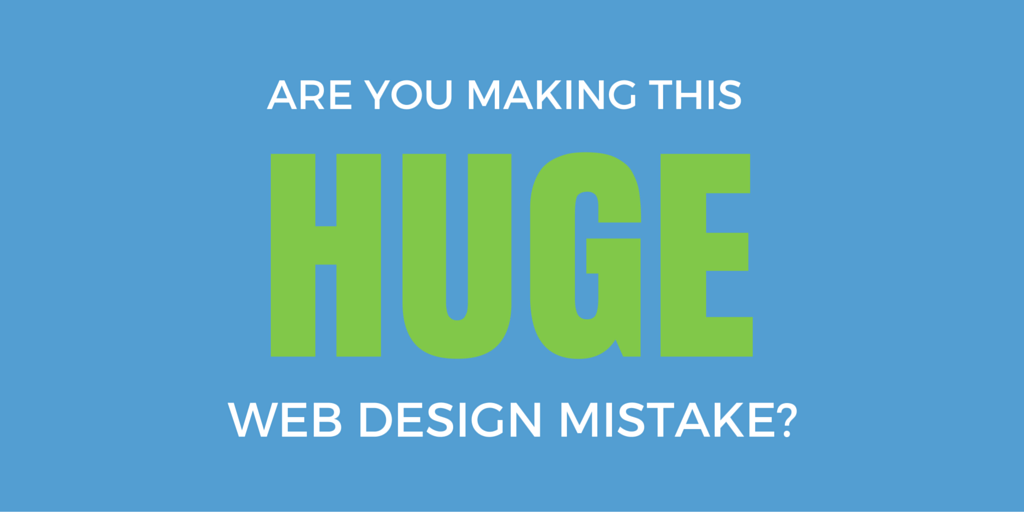
Before I start talking about the biggest web design mistake most people make, I need to mention that designing websites isn’t easy.
Everyone has an opinion on what looks the best.
Designers have their take on what’s best for your business. Owners have their view, and marketers provide another viewpoint.
At the end of the day, it isn’t easy to make everyone happy, and design by committee is never a good idea.
So when you start a web design project, keep in mind that it’s not going to be easy. You need to be open to the opinions and ideas of everyone providing input so you can get the best product possible, while also knowing who the final decision maker is and who’s opinion matters the most in the discussion.
With that said, there’s one very big mistake businesses make when it comes to designing their website.
The #1 Web Design Mistake People Make Is…
The #1 web design mistake people make is thinking they’re going to design the perfect site that won’t ever need to be changed.
Lots of time and effort goes into designing the site, but once it’s finished, it’s going to be perfect and won’t need to be updated for a year or two or more.
That’s the prevailing thought, anyway, but it’s wrong.
The problem with this line of thinking is that it’s difficult (if not impossible) to design the perfect website in a vacuum. What really matters is how your site performs when it makes contact with the outside world.
Do the words you chose for a headline make sense to people and compel them to take action? Are the menu items labelled properly, or are they confusing because you decided to get a little too cute with what you labelled them?
What about the layout and your conversion funnel? Do you have the best layout in place on your homepage to convince people to the action you want them to take? Do you have all the supplementary pages you need to give visitors the information they need to make a decision?
These are just a handful of the questions you have to ask after a website is designed.
What This Means for You
What this means for you as a marketer and business owner is that you shouldn’t be too worried about getting the perfect design the first time around. Yes, you want to pay attention to all of the details and make sure it’s as good as possible, just don’t stress over the fact that it has to be perfect or else it’s going to be a complete failure.
Next, make sure you have a testing, updating, and modification plan in place. If your website does end up being perfect, you won’t need to make any updates in the first 12 to 24 months. On the other hand, if it isn’t perfect (trust me, it won’t be), then you need to have a designer and developers on call to make the changes that need to be made.
You may need to change the headline because you realize that it doesn’t quite capture what it is that you need to say.
You may also need to add a PPC landing page or just another product page that gives visitors more information about your service. Maybe the menu needs to be tweaked or a new page needs to be added to the menu.
No matter what, you want to make sure you have the resources at hand to make all of these changes when you need so you don’t make the mistake of thinking that the web design process ends when the finished product is delivered.
Don’t Forget about A/B Testing
You also want to make sure and not forget about A/B testing. Sure, your team is doing the best job it can to make your site as persuasive as possible, but they likely won’t get it perfect the first time around.
That’s ok. Just make sure you have a testing plan in place to see if you’re using the most persuasive headline, sub-headline, body copy, CTA, page layout, etc. as possible.
Every website can benefit from A/B tests, no matter how “perfectly” the initial design turned out.
The Takeaway
The main takeaway from this is not to make the mistake in thinking that you’re going to stick the landing so well with the initial design that you won’t need to make any changes for two to five years.
That’s not going to happen, so go ahead and get that thought out of your system right now.
Instead, plan for changes and even embrace the challenge of A/B testing to make your website better because if you’re not incrementally improving your website, your competition will, and eventually they’ll leave you in the dust.
Share your two cents: What’s your take? Have you experience this firsthand, or do you have any advice to add? Be sure to leave a comment in order to join the discussion!
Author
 Joe Putnam is the Director of Marketing at iSpionage. You can get his latest PPC and CRO advice on Twitter at @josephputnam.
Joe Putnam is the Director of Marketing at iSpionage. You can get his latest PPC and CRO advice on Twitter at @josephputnam.







